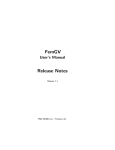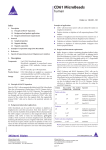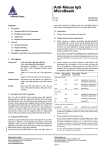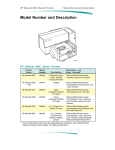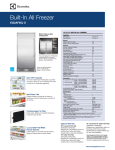Download CD45RO MicroBeads
Transcript
CD45RO MicroBeads human Order no. 130-046-001 Index Examples of applications 1.Description ● Depletion of human CD45RO+ cells from peripheral blood or lymphoid tissue for further selection of CD45RO– naive T cell subsets. ● Positive selection or depletion of human CD45RO+ memory T cells from preselected CD4+ or CD8+ cells isolated from peripheral blood using MACS Cell Isolation Kits1,2, or from lymphoid tissue using MACS MultiSort Kits3,4. ● Isolation of human CD45RA+ naive T cells from presorted CD4+ or CD8+ cells by depletion of CD45RO+ cells.5 1.1 Principle of MACS® Separation 1.2 Background and product applications 1.3 Reagent and instrument requirements 2.Protocol 2.1 Sample preparation 2.2 Magnetic labeling 2.3 Magnetic separation 3. Examples of separations using CD45RO MicroBeads 1.3 Reagent and instrument requirements 4.References ● Buffer: Prepare a solution containing phosphate-buffered saline (PBS) pH 7.2, 0.5% bovine serum albumin (BSA), and 2 mM EDTA by diluting MACS BSA Stock Solution (# 130-091-376) 1:20 with autoMACS™ Rinsing Solution (# 130-091-222). Keep buffer cold (4−8 °C). Degas buffer before use, as air bubbles could block the column. ▲ Note: EDTA can be replaced by other supplements such as anticoagulant citrate dextrose formula-A (ACD-A) or citrate phosphate dextrose (CPD). BSA can be replaced by other proteins such as human serum albumin, human serum, or fetal calf serum. Buffers or media containing Ca2+ or Mg2+ are not recommended for use. ● MACS Columns and MACS Separators: CD45RO+ cells can be enriched by using MS, LS or XS Columns (positive selection). CD45RO MicroBeads can be used for depletion of CD45RO+ cells on LD, CS or D Columns. Cells which strongly express the CD45RO antigen can also be depleted using MS, LS or XS Columns. CD45RO MicroBeads are less suitable for depletion or enrichment of monocytes, macrophages and granulocytes. Positive selection or depletion can also be performed by using the autoMACS Separator. 1.Description Components Size 2 mL CD45RO MicroBeads, human: MicroBeads conjugated to monoclonal mouse anti-human CD45RO antibodies (isotype: mouse IgG2a). For 109 total cells; up to 100 separations. Product format CD45RO MicroBeads are supplied as a suspension containing stabilizer and 0.05% sodium azide. Storage Store protected from light at 4–8 °C. Do not freeze. The expiration date is indicated on the vial label. 1.1 Principle of MACS® Separation First the CD45RO+ cells are magnetically labeled with CD45RO MicroBeads. Then the cell suspension is loaded on a MACS® Column which is placed in the magnetic field of a MACS Separator. The magnetically labeled CD45RO+ cells are retained on the column. The unlabeled cells run through, this cell fraction is depleted of CD45RO+ cells. After removal of the column from the magnetic field, the magnetically retained CD45RO+ cells can be eluted as the positively selected cell fraction. Column max. number max. number Separator of labeled cells of total cells Positive selection MS107 2×108 MiniMACS, OctoMACS, VarioMACS, SuperMACS LS108 2×109 MidiMACS, QuadroMACS, VarioMACS, SuperMACS 1.2 Background and product applications XS109 2×1010 SuperMACS CD45RO MicroBeads were developed for direct magnetic labeling of lymphocyte subsets. CD45RO is brightly expressed on CD4+ and CD8+ T cell subsets, and in a lower amount on monocytes, macrophages and granulocytes. The CD45RO antibody recognizes a 180 kDa isoform of the leukocyte common antigen (LCA). Depletion 140-000-039.07 CD45RO MicroBeads can be used for the positive selection or depletion of CD45RO+ cells. For isolation of CD45RO+ T cell subsets the CD45RO MicroBeads can be combined with MACS CD4+ and CD8+ T Cell Isolation Kits1,2 or CD4+ and CD8+ MultiSort Kits3,4. Cells isolated with CD45RO MicroBeads can be used for various studies, such as cytokine expression6 or receptor signaling. Miltenyi Biotec GmbH Friedrich-Ebert-Str. 68 51429 Bergisch Gladbach, Germany Phone +49-2204-8306-0 Fax +49-2204-85197 LD108 5×108 2×108 CS MidiMACS, QuadroMACS, VarioMACS, SuperMACS VarioMACS, SuperMACS D109 SuperMACS Positive selection or depletion autoMACS2×108 4×109 autoMACS ▲ Note: Column adapters are required to insert certain columns into the VarioMACS™ or SuperMACS™ Separators. For details see the respective MACS Separator data sheet. Miltenyi Biotec Inc. 2303 Lindbergh Street, Auburn, CA 95602, USA Phone 800 FOR MACS, 530 888-8871 Fax 530 888-8925 page 1/3 Order no. 130-046-001 ● (Optional) ● ● Fluorochrome-conjugated CD45RO antibody, additional fluorochrome-conjugated staining antibodies, e.g. CD4-FITC (# 130-080-501), CD8-APC (# 130-091-076), CD25PE (# 130-091-024). 7. (Optional) PI (propidium iodide) or 7-AAD for the flow cytometric exclusion of dead cells. ▲ Note: For higher cell numbers, scale up buffer volume accordingly. ▲ Note: For depletion with LD Columns, resuspend up to 1.25×108 cells in 500 µL of buffer. (Optional) Pre-Separation Filters (# 130-041-407) to remove dead cells. (# 130-080-501) and refrigerate for 5 minutes (4–8 °C). Wash cells by adding 1–2 mL of buffer per 107 cells and centrifuge at 300×g for 10 minutes. Aspirate supernatant completely. 8. Resuspend up to 108 cells in 500 µL of buffer. 9. Proceed to magnetic separation (2.3). 2.Protocol When working with anticoagulated peripheral blood or buffy coat, peripheral blood mononuclear cells (PBMCs) should be isolated by density gradient centrifugation, e.g. using Ficoll-Paque™. For details see section General Protocols in the User Manuals or visit www.miltenyibiotec.com/protocols. ▲ Note: To remove platelets after density gradient separation, resuspend cell pellet in buffer and centrifuge at 200×g for 10−15 minutes at 20 °C. Carefully aspirate supernatant. Repeat washing step. When working with tissues, prepare a single-cell suspension by a standard preparation method. For details see section General Protocols in the User Manuals or visit www.miltenyibiotec.com/ protocols. ▲ Note: Dead cells may bind non-specifically to MACS MicroBeads. To remove dead cells, we recommend using density gradient centrifugation or the Dead Cell Removal Kit (# 130-090-101). 2.2 Magnetic labeling ▲ Work fast, keep cells cold, and use pre-cooled solutions. This will prevent capping of antibodies on the cell surface and non-specific cell labeling. 2.3 Magnetic separation ▲ Choose an appropriate MACS Column and MACS Separator according to the number of total cells and the number of CD45RO+ cells. For details see table in section 1.3.. Magnetic separation with MS or LS Columns 1. Place column in the magnetic field of a suitable MACS Separator. For details refer to the respective MACS Column data sheet. 2. Prepare column by rinsing with appropriate amount of buffer: MS: 500 µL LS: 3 mL 3. Apply cell suspension onto the column. 4. Collect unlabeled cells that pass through and wash column with appropriate amount of buffer. Perform washing steps by adding buffer three times. Only add new buffer when the column reservoir is empty. MS: 3×500 µL LS: 3×3 mL Collect total effluent; this is the unlabeled cell fraction. 5. Remove column from the separator and place it on a suitable collection tube. ▲ Volumes for magnetic labeling given below are for up to 107 total cells. When working with fewer than 107 cells, use the same volumes as indicated. When working with higher cell numbers, scale up all reagent volumes and total volumes accordingly (e.g. for 2×107 total cells, use twice the volume of all indicated reagent volumes and total volumes). 6. Pipette an appropriate amount of buffer onto the column. Immediately flush out the magnetically labeled cells by firmly pushing the plunger into the column. MS: 1 mL LS: 5 mL ▲ For optimal performance it is important to obtain a singlecell suspension before magnetic separation. Pass cells through 30 µm nylon mesh (Pre-Separation Filters, # 130-041-407) to remove cell clumps which may clog the column. Magnetic separation with XS Columns ▲ If CD45RO MicroBeads are used for positive selection of CD45RO+ T helper or cytotoxic/suppressor cells in combination with CD4 or CD8 MultiSort Kit, we recommend using a 1:20 dilution (instead of 1:5) for the magnetic labeling. This increases the purity of the CD4+CD45RO+ and CD8+CD45RO+ cells, respectively, but may decrease the recovery. 1. Determine cell number. 2. Centrifuge at 300×g for 10 minutes. Aspirate supernatant completely. 3. Resuspend cell pellet in 80 µL of buffer per 107 total cells. 4. Add 20 µL of CD45RO MicroBeads per 107 total cells. 5. Mix well and refrigerate for 15 minutes (4–8 °C). 140-000-039.07 ▲ Note: Working on ice may require increased incubation times. Higher temperatures and/or longer incubation times lead to non-specific cell labeling. 6. (Optional) Add staining antibodies, e.g. add 10 µL CD4-FITC ▲ Note: To increase the purity of the magnetically labeled fraction pass the cells over a new, freshly prepared column. For instructions on the column assembly and the separation, refer to the XS Column data sheet. Depletion with LD Columns 1. Place LD Column in the magnetic field of a suitable MACS Separator. For details see LD Column data sheet. 2. Prepare column by rinsing with 2 mL of buffer. 3. Apply cell suspension onto the column. 4. Collect unlabeled cells which pass through and wash column with 2×1 mL of buffer. Collect total effluent. This is the unlabeled cell fraction. Depletion with CS Columns 1. Assemble CS Column and place it in the magnetic field of a suitable MACS Separator. For details see CS Column data sheet. 2. Prepare column by filling and rinsing with 60 mL of buffer. Attach a 22G flow resistor to the 3-way-stopcock of the assembled column. For details see CS Column data sheet. Unless otherwise specifically indicated, Miltenyi Biotec products and services are for research use only and not for diagnostic or therapeutic use. page 2/3 Order no. 130-046-001 3. Apply cell suspension onto the column. 4.References 4. Collect unlabeled cells which pass through and wash column with 30 mL buffer from top. Collect total effluent. This is the unlabeled cell fraction. 1. Krug, A. et al. (2001) Toll-like receptor reveals CpG DNA as a unique microbial stimulus for plasmacytoid dendritic cells which synergizes with CD40 ligand to induce high amounts of IL-12. Eur. J. Immunol. 31: 3026–3037. [1215] 2. Coccia, EM. et al. (1999) Interleukin-12 Induces Expression of Interferon Regulatory Factor-1 via Signal Transducer and Activator of Transcription-4 in Human T Helper Type 1 Cells. J. Biol. Chem. 274: 6698–6703. [680] 3. Wolthers, K. C.et al. (1999) Normal T-Cell Telomerase Activity and Upregulation in Human Immunodeficiency Virus-1 Infection. Blood 93: 1011–1019. [570] 4. Jonuleit, H. et al. (2001) Identification and Functional Characterisation of Human CD4+ CD25+ T Cells with Regulatory Properties Isolated from Peripheral Blood. J. Exp. Med. 193: 1285–1294. [1038] ▲ Refer to the autoMACS™ User Manual for instructions on how to use the autoMACS Separator. 5. Kimmig, S. et al. (2002) Two Subsets of Naive T Helper Cells with Distinct T Cell Receptor Excision Circle Content in Human Adult Peripheral Blood. J. Exp. Med. 195: 789–794. [1294] 1. 6. Malmberg, K. J.et al. (2001) Inhibition of Activated/Memory (CD45RO+) T Cells by Oxidative Stress Associated with Block of NF-κB Activation. J. Immunol. 167: 2595–2601. [2490] Depletion with D Columns For instructions on column assembly and separation refer to the D Column data sheet. Magnetic separation with the autoMACS™ Separator Prepare and prime autoMACS Separator. 2. Place tube containing the magnetically labeled cells in the autoMACS Separator. For a standard separation, choose one of the following separation programs: Positive selection: "Possel" Depletion: "Depletes" ▲ Note: Program choice depends on the isolation strategy, the strength of magnetic labeling, and the frequency of magnetically labeled cells. For details see autoMACS User Manual, section autoMACS Cell Separation Programs. 3. When using the program "Possel", collect positive fraction from outlet port pos1. This is the purified CD45RO+ cell fraction. When using the program "Depletes", collect unlabeled fraction from outlet port neg1. This is the CD45RO- cell fraction. 3. Examples of separations using CD45RO MicroBeads CD45RO+ cells were separated from PBMCs using CD45RO MicroBeads. For positive selection CD45RO+ cells were isolated using an MS Column and a MiniMACS™ Separator (A). For depletion of CD45RO+ cells, the sample was separated over an LD Column in a MidiMACS™ Separator. Cells are fluorescently stained with CD45RO-FITC (B). Warranty The products sold hereunder are warranted only to be free from defects in workmanship and material at the time of delivery to the customer. Miltenyi Biotec GmbH makes no warranty or representation, either expressed or implied, with respect to the fitness of a product for a particular purpose. There are no warranties, expressed or implied, which extend beyond the technical specifications of the products. Miltenyi Biotec GmbH’s liability is limited to either replacement of the products or refund of the purchase price. Miltenyi Biotec GmbH is not liable for any property damage, personal injury or economic loss caused by the product. autoMACS and MACS are registered trademarks and MidiMACS, MiniMACS, OctoMACS, QuadroMACS, SuperMACS, and VarioMACS are trademarks of Miltenyi Biotec GmbH. Ficoll-Paque is a trademark of GE Healthcare companies. Copyright © 2012 Miltenyi Biotec GmbH. All rights reserved. Relative cell number CD45RO-FITC PBMCs before separation CD45RO- cells 140-000-039.07 Relative cell number CD45RO-FITC Relative cell number B Reagents contain sodium azide. Under acidic conditions sodium azide yields hydrazoic acid, which is extremely toxic. Azide compounds should be diluted with running water before discarding. These precautions are recommended to avoid deposits in plumbing where explosive conditions may develop. CD45RO+ cells PBMCs before separation Relative cell number A Warnings CD45RO-FITC CD45RO-FITC Unless otherwise specifically indicated, Miltenyi Biotec products and services are for research use only and not for diagnostic or therapeutic use. page 3/3



